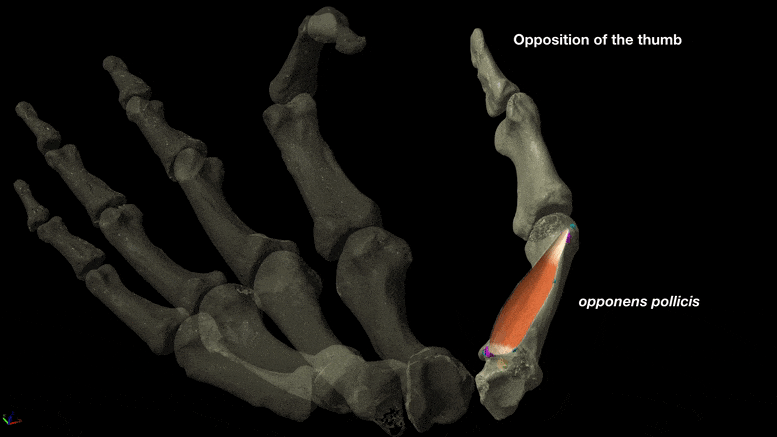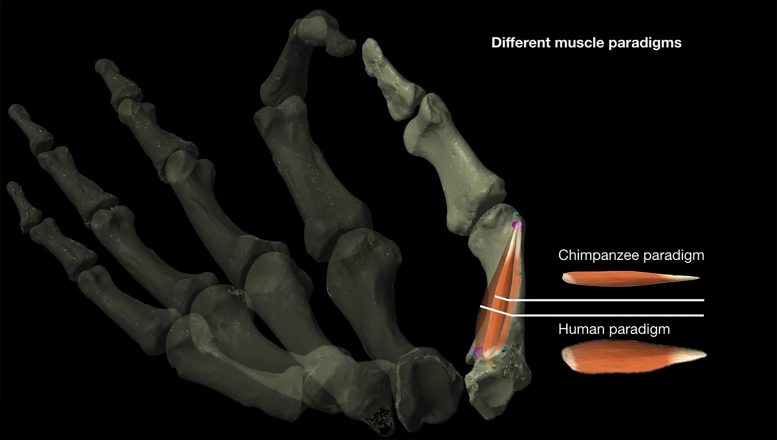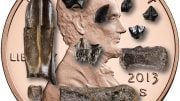
A crucial aspect of human thumb opposition emerged around 2 million years ago and was not present in the earliest known stone tool makers.
Despite long-standing ideas about the importance of thumb evolution in tool use and development, questions remain about exactly when human-like manual dexterity and efficient thumb use arose — and which hominin species was the first to have this ability. Now, researchers who’ve analyzed the biomechanics and efficiency of the thumb across different fossil human species using virtual muscle modeling have new insight into when these abilities first arose and what they’ve meant for the development of more complex human culture. The findings, appearing today (January 28, 2021) in the journal Current Biology, suggest that a fundamental aspect of human thumb opposition first appeared approximately 2 million years ago and was not found in the earliest proposed stone tool makers.
“Increased manual dexterity in the form of efficient thumb opposition was among the early defining characteristics of our lineage, providing a formidable adaptive advantage to our ancestors,” said Katerina Harvati of the Eberhard Karls University of Tübingen. “It is likely a crucial element underlying the development of complex culture over the last 2 million years, shaping our biocultural evolution.”
Earlier attempts to study thumb dexterity evolution had relied on comparisons between the skeletal anatomy of modern humans and earlier hominin species. The assumption was that similarities in skeletal remains to the human form could be taken as evidence of dexterity. In the new study, the team led by Harvati took a new and more comprehensive approach.

This image diagrams the difference between human and chimpanzee models of thumb muscles, which the researchers used to study the evolution of thumb dexterity. Credit: Professor Katerina Harvati, Dr. Alexandros Karakostis, and Dr. Daniel Haeufle
“Our methodology integrates cutting-edge virtual muscle modeling with three-dimensional analysis of bone shape and size,” first author and hand biomechanics expert Alexandros Karakostis, explains. “This process includes the precise 3D study of the areas of the bones where muscles attach in life. Importantly, we were able to validate the predictions of our models by confirming that the differences observed between living taxa — chimpanzees and modern humans — reflect those reported from past experimental studies.”
By applying this new approach to answer the question, the researchers showed that thumb efficiency and dexterity had increased to a significant extent in hominins that lived 2 million years ago in South Africa. At the same time, they found that the degree of this dexterity was consistently lower in the earliest proposed tool-making species, the Australopithecines. That includes the species Australopithecus sediba, which is also dated to approximately 2 million years ago. That’s notable because researchers had previously suggested that the human-like thumb proportions of A. sediba reflected tool-making capabilities.
“One of the greatest surprises was to find that hominin hand fossils from the Swartkrans site in South Africa, which date to ca. 2 million years ago and are attributed to either early Homo or to the extinct hominin side branch Paranthropus robustus, could achieve a thumb-using dexterity similar to that of modern humans,” Karakostis said.
The new findings further show that later-arising species, belonging to our own genus Homo — including Neanderthals as well as early and recent Homo sapiens — share similarly high degrees of manual dexterity. Those findings applied also to the small-brained species Homo naledi, despite the fact that this species has not yet been found in association with stone tools.
“These consistently high dexterity levels in species of Homo are indicative of the great adaptive value of thumb opposition for human biocultural evolution,” Harvati says.
The researchers note that the most important implication of their new findings is that an early increase of thumb dexterity about 2 million years ago may have been a foundation for the gradual development of complex culture. They highlight that this timeframe includes important biocultural developments such as the appearance of the large-brained Homo erectus lineage and its dispersal out of Africa. Around the same time, humans gradually began to exploit animal resources and rely more heavily on stone tool technologies.
The researchers now plan to look even more closely at specific groups, such as Neanderthals, so as to further elucidate the details of their manual dexterity and how they may have differed from that of modern humans. They’ll also more closely investigate the habitual manual activities of early hominins to further shed light on the behaviors that marked the transition to systematic tool production and use among our distant ancestors.
Reference: “Biomechanics of the human thumb and the evolution of dexterity” by Fotios Alexandros Karakostis” by Daniel Haeufle, Ioanna Anastopoulou, Konstantinos Moraitis, Gerhard Hotz, Vangelis Tourloukis and Katerina Harvati, 28 January 2021, Current Biology.
DOI: 10.1016/j.cub.2020.12.041
This work was supported by the European Research Council, the German Research Foundation, and the Ministry of Science, Research, and the Arts Baden-Württemberg.









Be the first to comment on "Tracing the History of Hominin Thumb Dexterity by Modeling Ancient Thumbs"